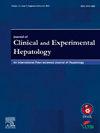Efficacy and Safety of Direct Oral Anticoagulants Compared to Vitamin K Antagonists for Atrial Fibrillation in Patients With Liver Cirrhosis: An Update Systematic Review and Meta-analysis
IF 3.3
Q2 GASTROENTEROLOGY & HEPATOLOGY
Journal of Clinical and Experimental Hepatology
Pub Date : 2025-02-25
DOI:10.1016/j.jceh.2025.102534
引用次数: 0
Abstract
Background
This meta-analysis aimed to compare the efficacy and safety of direct oral anticoagulants (DOACs) with vitamin K antagonists (VKAs) in patients with concomitant atrial fibrillation (AF) and liver cirrhosis (LC).
Methods
PubMed, Cochrane Library, Embase, Scopus, Web of Science, and China National Knowledge Infrastructure (CNKI) databases were searched for randomized clinical trials (RCTs) and non-RCTs comparing DOACs and VKAs in patients with AF and LC. Analyses were performed in R software. A random-effects model was employed to calculate the pooled hazard ratio (HR).
Results
Eleven studies encompassing 19,617 patients were included, with 9379 receiving DOACs and 10,238 receiving VKAs. DOACs were associated with a significant reduction in the incidence of major bleeding (HR 0.70; 95% CI: 0.61–0.81; P < 0.001; I2 = 0%), all-cause mortality (HR 0.87; 95% CI: 0.78–0.98; P = 0.022; I2 = 41%), and gastrointestinal bleeding (HR 0.75; 95% CI: 0.67–0.84; P < 0.001; I2 = 4%). No significant difference was observed for thromboembolic events (HR 0.86; 95% CI: 0.69–1.06; P = 0.153; I2 = 0%).
Conclusion
DOACs may be a feasible option for patients with AF and LC, demonstrating similar effectiveness to VKAs while exhibiting a better safety profile. These findings await validation by prospective studies.

与维生素K拮抗剂相比,直接口服抗凝剂治疗肝硬化心房颤动的疗效和安全性:一项最新的系统评价和荟萃分析
本荟萃分析旨在比较直接口服抗凝剂(DOACs)与维生素K拮抗剂(VKAs)在合并心房颤动(AF)和肝硬化(LC)患者中的疗效和安全性。方法检索spubmed、Cochrane Library、Embase、Scopus、Web of Science、中国知网(CNKI)等数据库,检索比较AF和LC患者DOACs和vka的随机临床试验(rct)和非rct。在R软件中进行分析。采用随机效应模型计算合并风险比(HR)。结果共纳入6项研究,共19617例患者,其中9379例接受doac治疗,10238例接受vka治疗。DOACs与大出血发生率显著降低相关(HR 0.70;95% ci: 0.61-0.81;P & lt;0.001;I2 = 0%),全因死亡率(HR 0.87;95% ci: 0.78-0.98;p = 0.022;I2 = 41%)和胃肠道出血(HR 0.75;95% ci: 0.67-0.84;P & lt;0.001;i2 = 4%)。血栓栓塞事件无显著性差异(HR 0.86;95% ci: 0.69-1.06;p = 0.153;i2 = 0%)。结论doacs可能是房颤和LC患者的可行选择,其疗效与vka相似,同时具有更好的安全性。这些发现有待于前瞻性研究的验证。
本文章由计算机程序翻译,如有差异,请以英文原文为准。
求助全文
约1分钟内获得全文
求助全文
来源期刊

Journal of Clinical and Experimental Hepatology
GASTROENTEROLOGY & HEPATOLOGY-
CiteScore
4.90
自引率
16.70%
发文量
537
审稿时长
64 days
 求助内容:
求助内容: 应助结果提醒方式:
应助结果提醒方式:


